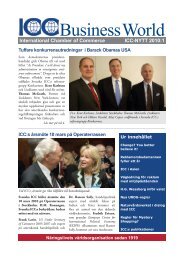Business in society Making a positive and responsible contribution A ...
Business in society Making a positive and responsible contribution A ...
Business in society Making a positive and responsible contribution A ...
You also want an ePaper? Increase the reach of your titles
YUMPU automatically turns print PDFs into web optimized ePapers that Google loves.
N<strong>in</strong>e practical steps to <strong>responsible</strong> bus<strong>in</strong>ess conductIf a company is consider<strong>in</strong>g whether to develop its own bus<strong>in</strong>ess pr<strong>in</strong>ciples or to supportexternal codes of conduct, the follow<strong>in</strong>g steps are suggested.Confirm CEO/board commitment to give priority to <strong>responsible</strong>bus<strong>in</strong>ess conductA basic requirement is the commitment of senior management to treat <strong>responsible</strong> bus<strong>in</strong>essconduct as a corporate priority. Rather than react<strong>in</strong>g to outside pressures, a company’s voluntaryadoption of its own bus<strong>in</strong>ess pr<strong>in</strong>ciples should be motivated by the desire to express the valuesthat guide its approach to do<strong>in</strong>g bus<strong>in</strong>ess.State company purpose <strong>and</strong> agree on company valuesResponsible bus<strong>in</strong>ess conduct is built upon the values <strong>and</strong> goals of the company itself, as wellas on legal requirements <strong>and</strong> stakeholder expectations. <strong>Bus<strong>in</strong>ess</strong> pr<strong>in</strong>ciples commonly <strong>in</strong>clude astatement of mission, values <strong>and</strong> operat<strong>in</strong>g pr<strong>in</strong>ciples. All companies should consider articulat<strong>in</strong>gtheir core values as an underp<strong>in</strong>n<strong>in</strong>g for their own pr<strong>in</strong>ciples.Identify key stakeholders<strong>Bus<strong>in</strong>ess</strong> pr<strong>in</strong>ciples set out what companies see as their responsibilities to employees,shareholders, customers, bus<strong>in</strong>ess partners <strong>and</strong> other groups <strong>in</strong> <strong>society</strong>. F<strong>in</strong>d<strong>in</strong>g out fromstakeholders what issues are important to them is therefore essential. Stakeholders — def<strong>in</strong>ed asthose constituencies that have a direct stake <strong>in</strong> a company — typically can <strong>in</strong>clude shareholders<strong>and</strong> <strong>in</strong>vestors, company employees, trade unions, client companies <strong>and</strong> consumers, <strong>and</strong> localcommunities directly affected by a company’s operations. A company may also wish to broadenits consultations to <strong>in</strong>clude other participants <strong>in</strong> the production cha<strong>in</strong>, as well as governmentauthorities, the media <strong>and</strong> non-governmental organizations. Companies should be m<strong>in</strong>dful of the







